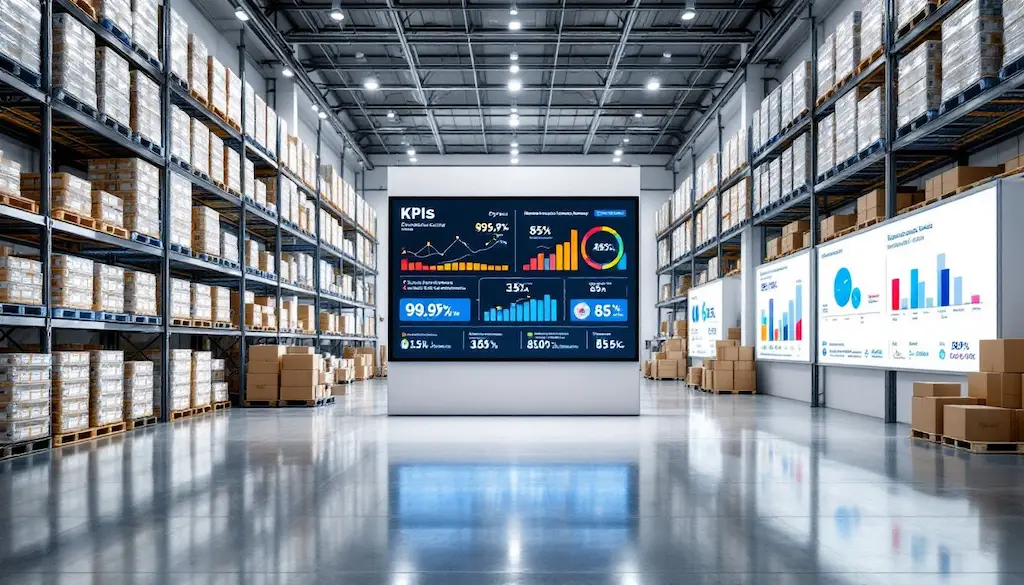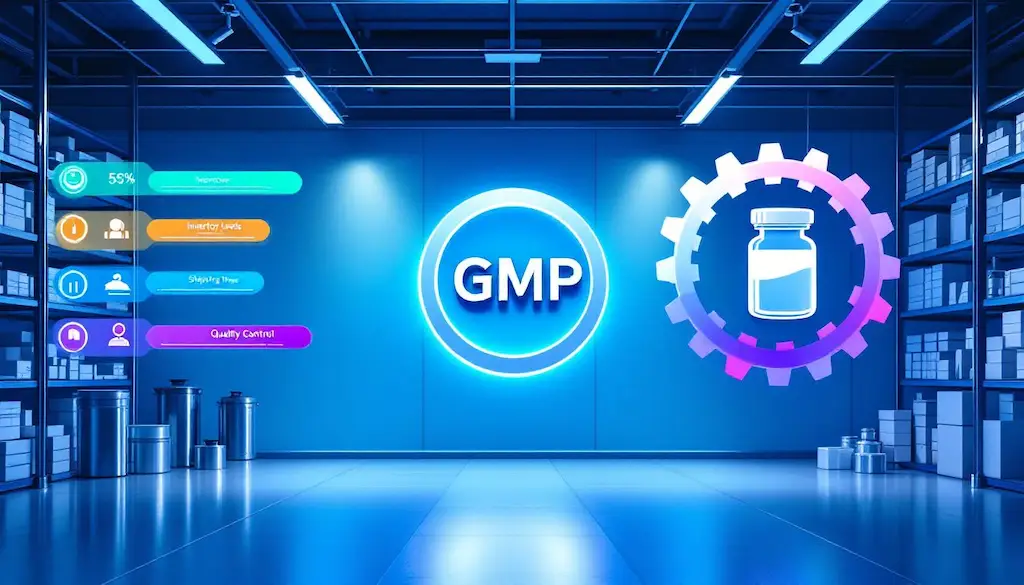Ensuring GMP for warehousing is crucial for maintaining product quality and safety in the pharmaceutical industry. This article covers essential guidelines and practices to help you comply with GMP standards, avoid costly mistakes, and protect your products.
Key Takeaways
- Good Manufacturing Practices (GMP) are essential for ensuring the quality and safety of pharmaceutical products in warehouses, minimizing risks of contamination and product deterioration.
- Key GMP regulations include proper storage conditions, pest control measures, and personnel hygiene training, which are critical for maintaining compliance and product integrity.
- Implementing advanced technology, such as automated inventory management and data analytics, enhances operational efficiency and compliance monitoring in pharmaceutical warehousing.
The Importance of GMP in Warehousing
Good Manufacturing Practices (GMP) are the backbone of quality and safety in the pharmaceutical industry and pharmaceutical warehousing. These regulations ensure consistent quality, integrity, and safety of products stored in warehouses, including those in a gmp warehouse. Adhering to GMP guidelines ensures the identity, strength, quality, and purity of pharmaceutical products, preserving their efficacy and safety for consumers. Pharmaceutical warehouses play a crucial role in this process, acting as the custodians of these valuable products until they reach their final destination.
Failure to comply with GMP standards can lead to severe consequences, including product recalls and significant damage to a company’s reputation. Beyond regulatory compliance, it demonstrates a commitment to producing high-quality products that consumers trust.
GMP guidelines minimize contamination risks and maximize product quality and efficacy, ensuring every product leaving the warehouse is fit for use. This commitment to quality control and safety is vital in maintaining consumer confidence and ensuring public health.
Key GMP Regulations for Pharmaceutical Warehouses
GMP regulations ensure product safety, efficacy, quality, integrity, and identity in pharmaceutical warehouses. Regulatory agencies like the FDA have established stringent GMP rules that warehouses must follow to maintain compliance. These regulations focus on various aspects of warehousing processes, including proper storage conditions, handling procedures, and documentation.
The key aspects of these regulations will be explored in detail in the following subsections.
Storage and Distribution Requirements
Storage and distribution requirements are vital for maintaining the integrity of pharmaceutical products. GMP regulations for storing raw materials include separate quarantine areas, temperature control, off-floor storage, expiration tracking, periodic inspections, and sealed containers. Finished products must be stored off the floors and away from walls, under appropriate conditions to maintain their integrity. Rejected stock must be placed into a separate, locked area to ensure proper segregation and prevent contamination.
Accurate documentation of storage conditions and labeling is essential to meet compliance, and all roller doors must be closed when not in use to maintain environmental controls. These measures ensure that the materials stored retain their quality and safety throughout their lifecycle.
Following these storage and distribution practices helps warehouses manage inventory and maintain high standards of product quality and supply chain safety.
Pest Control Measures
Pest control measures are critical in maintaining a clean and compliant warehouse environment. Routine pest control, sealing entry points, maintaining cleanliness, and monitoring for signs of pest activity are key practices to prevent infestations.
Common pests in pharmaceutical warehouses include rats, mice, birds, ants, and cockroaches, all of which can pose significant risks to product safety and integrity. These measures prevent contamination, ensuring stored products remain safe for consumer use.
Personnel Hygiene and Training
Strict hygiene practices and regular training for warehouse personnel are essential for preventing contamination and ensuring product safety. Personnel must adhere to hygiene practices such as proper handwashing and wearing protective clothing.
Training should cover contamination control and proper product handling to keep staff informed about best practices. Regular audits and assessments of hygiene practices are also necessary to ensure compliance with GMP standards.
Implementing Temperature Control in Pharmaceutical Warehouses

Temperature control is a critical aspect of pharmaceutical warehousing, as many medications are sensitive to heat or cold and require specific temperature ranges to maintain their efficacy. Proper temperature control maintains pharmaceutical quality and ensures regulatory compliance.
This section will explore the various systems and practices for temperature monitoring, mapping, and cold storage management necessary to maintain these conditions.
Temperature Monitoring Systems
Temperature monitoring systems are essential for maintaining compliance with GMP standards. Automated data logging within these systems ensures accurate and accessible records. Monitoring instruments must be readable, calibrated to national standards, and equipped with high/low-temperature alarms to alert personnel to any deviations. Recording both air and product temperatures is critical for comprehensive monitoring.
Strategically placing temperature sensors throughout the warehouse guarantees comprehensive monitoring and exposes hidden vulnerabilities. Effective data management involves reviewing, analyzing, and filing records of temperature monitoring appropriately. Establishing a robust alarm system that operates reliably and independently of the main electrical system is also crucial to respond to temperature deviations promptly.
Conducting Temperature Mapping
Temperature mapping is a process used to identify specific areas in the warehouse. These areas are prone to fluctuations in temperature. Conducting a thermal mapping study is essential to identify these deviations for proactive management. The first step in creating a temperature map is to develop a validation protocol. By studying the temperature profile, potential hot and cold areas can be identified using appropriate monitoring instruments.
The initial temperature profiling test aims to identify areas needing attention and those stable enough for storage. If significant risks are identified during a thermal mapping study, it is essential to address these risks and conduct a new risk assessment.
Data from temperature sensors should be accessed through secure channels and tabulated according to standardized regulations. Graphs and tables are commonly used representations for temperature data in reports.
Cold Storage Management
Cold storage management prevents product degradation from temperature fluctuations. Climate-controlled zones are necessary for storing temperature-sensitive items, with required storage temperature ranges for cold storage of products between 2°C-8°C and frozen materials below -20°C/-70°C. Chemicals that can deteriorate with heat exposure need proper storage. They should be kept at controlled temperatures or frozen.
Facilities must validate temperature recording instrumentation and processes for successful cold storage operation. Maintaining records of procedures and alarm responses is vital for cold storage operations. A written action plan for temperature changes affecting frozen materials must include contingency measures for potential relocation.
LED lighting is recommended in cold storage areas to maintain stable environmental temperatures.
Best Practices for GMP Compliance
Adhering to GMP regulations requires the implementation of best practices to ensure compliance and maintain product quality. These include strict hygiene and sanitation protocols, ongoing employee training, and the integration of advanced technologies. Regular audits and inspections, proper documentation, and effective risk management strategies are also crucial.
Following these best practices helps create a culture of quality and continuous learning, which is essential for effective current good manufacturing practice compliance.
Regular Audits and Inspections
Regular audits and inspections are crucial for ensuring GMP compliance. Audits help identify areas of non-compliance within the warehouse system. A robust internal auditing system can help warehouses stay proactive in addressing GMP-related issues. Monitoring adverse trends during audits helps address issues before they escalate.
Warehouse personnel must be trained on GMP rules, standard operating procedures, and safe handling to maintain compliance. Effective training increases awareness of GMP requirements among personnel, thereby supporting ongoing compliance. Regularly updating training content keeps staff knowledgeable about the evolving GMP landscape.
A comprehensive audit checklist should include all areas of warehouse activities to ensure thorough evaluations.
Proper Documentation and Record-Keeping
Accurate documentation demonstrates GMP compliance and ensures effective traceability. A well-documented report is essential for regulatory approval and ensuring product safety. Digital data must be stored securely to prevent unauthorized alterations and ensure data integrity. Compliance with regulations like US FDA 21 CFR Part 11 is necessary for digital record keeping in pharmaceutical warehouses.
Documenting stored products is vital for efficient inventory management, detailing batch numbers and expiry dates. Data analytics tools facilitate compliance monitoring by providing insights into inventory levels and expiration dates.
Risk Management Strategies
Risk management strategies should involve continuous improvement and proactive identification of potential GMP compliance issues. Everything in its place minimizes mix-ups and improves safety.
Leveraging data analytics enhances compliance monitoring by providing insights into operational processes and identifying potential areas of non-compliance.
Preventing Contamination and Deterioration
Preventing contamination and deterioration of pharmaceutical products is paramount in maintaining product quality and safety. Following GMP prevents contamination, mix-ups, and errors during storage and distribution.
This section will explore the critical measures that need to be taken, including segregation of materials and maintaining cleanliness and housekeeping practices, to ensure a compliant warehouse environment.
Segregation of Materials
Segregating materials ensures defective or recalled products do not mix with good stock. This practice helps maintain product integrity and minimizes the risk of contamination and mix-ups in the warehousing process.
It is acceptable for raw materials and finished products to not be segregated when managed through validated electronic inventory controls.
Cleanliness and Housekeeping
Maintaining cleanliness in pharmaceutical warehouses involves regular cleaning, proper storage, and immediate spill response. Cleaning practices must be comprehensive and include all surfaces, equipment, and storage areas to meet GMP standards.
Sealing entry points is a key pest control measure to prevent pests from entering pharmaceutical warehouses. Routine monitoring for pest activity maintains a compliant warehouse environment.
Security Measures in Pharmaceutical Warehouses

A secure environment protects pharmaceutical products from theft or tampering. This section will cover the necessary security measures, split into two subsections: Physical Access Controls and Digital Security Protocols. Implementing these measures ensures the safety and integrity of the products stored in the warehouse.
Physical Access Controls
Physical access controls are crucial in pharmaceutical warehouses to restrict unauthorized entry and safeguard products. Access control systems, surveillance, and secure storage for dangerous substances are essential security measures.
These controls mitigate risks and ensure safety by limiting access to sensitive areas and preventing theft or tampering.
Digital Security Protocols
Digital security protocols are equally important in pharmaceutical warehousing to protect sensitive information and ensure compliance with regulations. Limiting access to digital records to authorized individuals prevents unauthorized access.
Implementing stringent digital security protocols maintains data integrity and safeguards information, which is crucial for maintaining an efficient and compliant warehouse environment.
Developing a GMP Program for Your Warehouse
Developing a GMP program tailored to your warehouse operations is essential for maintaining compliance and ensuring product quality. Understanding regulatory requirements, identifying critical control points, and selecting appropriate equipment are fundamental for creating a robust GMP system.
By combining regulatory knowledge, critical control point identification, and proper equipment selection, warehouses can implement a comprehensive GMP program that meets all necessary standards.
The Role of Technology in GMP Warehousing
Technology plays a vital role in ensuring GMP compliance and optimizing warehouse operations. Regular audits and the integration of advanced technologies like automation and AI significantly enhance GMP standards and operational efficiency.
This section will explore how technology can be leveraged to improve compliance and streamline processes in pharmaceutical warehousing.
Automated Systems for Inventory Management
Automated inventory management systems enhance accuracy and reduce human error by enabling real-time tracking and monitoring of pharmaceutical products. These systems ensure precise tracking of pharmaceuticals, maintain optimal inventory levels, and prevent product mismanagement.
This automation is crucial for maintaining product integrity and supporting efficient warehouse operations.
Advanced Data Analytics
Advanced data analytics provide valuable insights that help pharmaceutical warehouses monitor compliance in real-time and optimize overall operations. Predictive analytics enhance decision-making by identifying potential compliance issues and optimizing warehouse operations through demand forecasting and effective stock management.
Using digital platforms for data management improves accuracy and access to critical information across warehouse operations.
ASC Software: Your Partner in GMP-Compliant Warehousing
Achieving and maintaining GMP compliance is a complex yet essential task in pharmaceutical warehousing. ASC Software simplifies this process with innovative solutions tailored to meet stringent regulatory requirements while optimizing operational efficiency.
Key Features of ASC Software’s GMP Solutions:
- Automated Inventory Management: Real-time tracking of inventory ensures accurate stock levels, reduces human error, and prevents product mix-ups.
- Temperature and Environmental Monitoring: Integrated systems continuously monitor and log temperature, humidity, and other critical factors, ensuring compliance with regulatory standards.
- Advanced Data Analytics: Gain actionable insights into inventory trends, compliance status, and risk areas to make informed decisions and streamline processes.
- Comprehensive Documentation Tools: Meet requirements like FDA 21 CFR Part 11 with secure, digital record-keeping solutions that ensure data integrity and traceability.
- Scalable and Customizable: Our solutions grow with your operations and can be tailored to address the specific needs of your warehouse.
Benefits of Choosing ASC Software:
- Enhance compliance with GMP standards while reducing operational risks.
- Increase efficiency through automation and integration of advanced technologies.
- Build trust with customers and regulators by ensuring consistent product quality and safety.
With ASC Software, you don’t just meet GMP compliance—you set the standard for excellence in pharmaceutical warehousing. Let us help you achieve seamless, secure, and efficient operations.
Summary
In summary, adhering to GMP regulations in pharmaceutical warehousing is essential for maintaining product quality, safety, and efficacy. From understanding the importance of GMP to implementing best practices and leveraging advanced technologies, each aspect plays a crucial role in ensuring compliance and optimizing warehouse operations. By following these guidelines, warehouses can ensure that every product reaches consumers in its best possible condition. Remember, maintaining GMP standards is not just about compliance; it’s about commitment to quality and consumer safety.
Ready to elevate your warehousing with GMP-compliant solutions? Contact ASC Software today to explore how our innovative systems can streamline your operations and ensure compliance!
Frequently Asked Questions
Why are GMP regulations important in pharmaceutical warehousing?
GMP regulations are essential in pharmaceutical warehousing as they safeguard the quality and safety of products by minimizing contamination risks and ensuring regulatory compliance. Adhering to these standards helps maintain the integrity and effectiveness of pharmaceutical goods.
What are the key storage and distribution requirements under GMP?
Key storage and distribution requirements under GMP involve maintaining separate quarantine areas, ensuring temperature control, storing materials off the floor, tracking expiration dates, conducting periodic inspections, and documenting storage conditions properly. Adhering to these requirements is essential for compliance and product integrity.
How does temperature control impact pharmaceutical product quality?
Effective temperature control is essential for ensuring the efficacy and safety of pharmaceutical products, as it prevents degradation and maintains their quality. Proper monitoring and storage are vital in safeguarding these temperature-sensitive medications.
What role does automation play in GMP warehousing?
Automation plays a crucial role in GMP warehousing by enhancing accuracy and reducing human error through real-time tracking and monitoring of pharmaceutical products, ultimately ensuring optimal inventory management. This leads to improved compliance and efficiency in the handling of regulated materials.
Why are regular audits and proper documentation important for GMP compliance?
Regular audits and proper documentation are essential for GMP compliance as they help pinpoint non-compliance issues and enhance operational efficiency. Furthermore, they guarantee traceability, regulatory adherence, and the safety of products.




